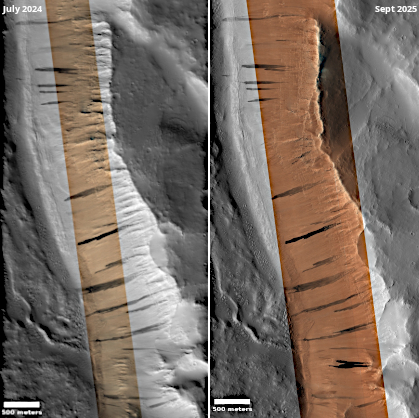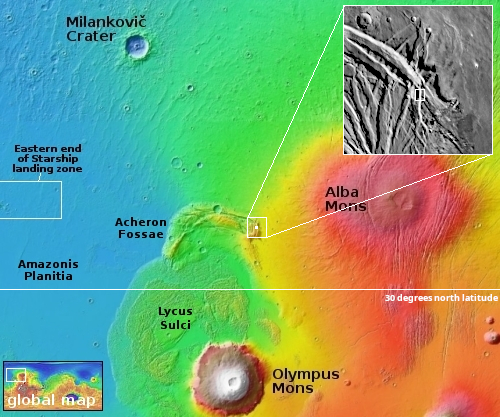Fresh slope streak on Mars

For original images go here and here.
Cool image time! One of the geological mysteries on Mars seen no where on Earth is something scientists have dubbed “slope streaks.” Though they at first glance appear to be avalanches, they do nothing to change the topography, have no debris pile at their base, and sometimes even travel up and over rises on their way downhill. They can also appear randomly throughout the year, can be bright or dark, and fade with time.
No theory as to their cause has yet been accepted, though recent research suggests they are dry events, dust avalanches triggered by dust devils, wind, or the accumulation of dust.
To better understand this geology, scientists repeatedly monitor known slope streak locations looking for changes. The two images to the right are an example, downloaded from the high resolution camera on Mars Reconnaissance Orbiter (MRO) on July 2, 2024 and September 1, 2025. In the fourteen months that passed between the first and second images, two distinct and large slope streaks occurred next to each other, near the bottom of the picture. All the other streaks merely faded.

The white dot inside the rectangle on the overview map to the right marks the location, on a point where the western and northern flanks of the two giant shield volcanos Alba Mons and Olympia Mons meet. The location also appears to have been a vent where lava issued.
The cliff where these slope streaks are located itself ranges in height from 800 to 2,000 feet. Note too that all along its length are slope streaks, not just in the area photographed.
If the present theory is correct, sometime in the past year something disturbed the dust at the top, causing it to cascade down the slope in two sections to produce the dark streaks we see now. The cause might simply have been the seasonal freeze-thaw cycle, as this is at 37 degrees north latitude where near surface ice is found. Or maybe a dust devil came by and shook the dust.
Regardless, something happened to cause the streak. This monitoring will allow scientists to track the changes to measure their frequency and determine if they are linked to the seasons in any way.
On Christmas Eve 1968 three Americans became the first humans to visit another world. What they did to celebrate was unexpected and profound, and will be remembered throughout all human history. Genesis: the Story of Apollo 8, Robert Zimmerman's classic history of humanity's first journey to another world, tells that story, and it is now available as both an ebook and an audiobook, both with a foreword by Valerie Anders and a new introduction by Robert Zimmerman.
The print edition can be purchased at Amazon or from any other book seller. If you want an autographed copy the price is $60 for the hardback and $45 for the paperback, plus $8 shipping for each. Go here for purchasing details. The ebook is available everywhere for $5.99 (before discount) at amazon, or direct from my ebook publisher, ebookit. If you buy it from ebookit you don't support the big tech companies and the author gets a bigger cut much sooner.
The audiobook is also available at all these vendors, and is also free with a 30-day trial membership to Audible.
"Not simply about one mission, [Genesis] is also the history of America's quest for the moon... Zimmerman has done a masterful job of tying disparate events together into a solid account of one of America's greatest human triumphs."--San Antonio Express-News

For original images go here and here.
Cool image time! One of the geological mysteries on Mars seen no where on Earth is something scientists have dubbed “slope streaks.” Though they at first glance appear to be avalanches, they do nothing to change the topography, have no debris pile at their base, and sometimes even travel up and over rises on their way downhill. They can also appear randomly throughout the year, can be bright or dark, and fade with time.
No theory as to their cause has yet been accepted, though recent research suggests they are dry events, dust avalanches triggered by dust devils, wind, or the accumulation of dust.
To better understand this geology, scientists repeatedly monitor known slope streak locations looking for changes. The two images to the right are an example, downloaded from the high resolution camera on Mars Reconnaissance Orbiter (MRO) on July 2, 2024 and September 1, 2025. In the fourteen months that passed between the first and second images, two distinct and large slope streaks occurred next to each other, near the bottom of the picture. All the other streaks merely faded.

The white dot inside the rectangle on the overview map to the right marks the location, on a point where the western and northern flanks of the two giant shield volcanos Alba Mons and Olympia Mons meet. The location also appears to have been a vent where lava issued.
The cliff where these slope streaks are located itself ranges in height from 800 to 2,000 feet. Note too that all along its length are slope streaks, not just in the area photographed.
If the present theory is correct, sometime in the past year something disturbed the dust at the top, causing it to cascade down the slope in two sections to produce the dark streaks we see now. The cause might simply have been the seasonal freeze-thaw cycle, as this is at 37 degrees north latitude where near surface ice is found. Or maybe a dust devil came by and shook the dust.
Regardless, something happened to cause the streak. This monitoring will allow scientists to track the changes to measure their frequency and determine if they are linked to the seasons in any way.
On Christmas Eve 1968 three Americans became the first humans to visit another world. What they did to celebrate was unexpected and profound, and will be remembered throughout all human history. Genesis: the Story of Apollo 8, Robert Zimmerman's classic history of humanity's first journey to another world, tells that story, and it is now available as both an ebook and an audiobook, both with a foreword by Valerie Anders and a new introduction by Robert Zimmerman.
The print edition can be purchased at Amazon or from any other book seller. If you want an autographed copy the price is $60 for the hardback and $45 for the paperback, plus $8 shipping for each. Go here for purchasing details. The ebook is available everywhere for $5.99 (before discount) at amazon, or direct from my ebook publisher, ebookit. If you buy it from ebookit you don't support the big tech companies and the author gets a bigger cut much sooner.
The audiobook is also available at all these vendors, and is also free with a 30-day trial membership to Audible.
"Not simply about one mission, [Genesis] is also the history of America's quest for the moon... Zimmerman has done a masterful job of tying disparate events together into a solid account of one of America's greatest human triumphs."--San Antonio Express-News

